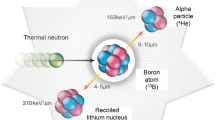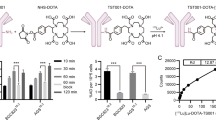Abstract
Purpose
The effect of vascular disrupting agent ZD6126 with time on the sensitivity to the hypoxic cytotoxin tirapazamine (TPZ) and γ-rays was examined in large and small solid tumors.
Methods
Mice bearing SCC VII tumors 1 or 1.5 cm in diameter received 5-bromo-2′-deoxyuridine (BrdU) continuously to label all proliferating (P) cells, followed by injection with or without ZD6126. In the absence of ZD6126, or 1 or 24 h following ZD6126 injection, the response to TPZ or γ-ray irradiation in quiescent (Q) cells was assessed in terms of induced micronucleus (MN) frequency using immunofluorescence staining for BrdU. The MN frequency in the total cell population was determined from the tumors not pretreated with BrdU. Another group of tumor-bearing mice received a series of test doses of γ-rays while alive or after tumor clamping to obtain hypoxic fractions (HFs) in the tumors.
Results
One hour after ZD6126 injection, both small and large tumors showed lower and higher sensitivity, and 24 h after, higher and lower sensitivity, to γ-rays and TPZ, respectively, than the tumors not treated with ZD6126. Further, they showed larger and smaller HFs 1 and 24 h after ZD6126 injection, respectively. Without ZD6126 and 1 h after injection, small tumors were more sensitive to γ-rays and less sensitive to TPZ than large tumors, probably due to the smaller HFs than large tumors. In contrast, 24 h after the injection, these differences in sensitivity and the HF between small and large tumors were reversed. The changes in sensitivity and the size of the HF were more marked in the total cell population than in Q cells.
Conclusions
Following ZD6126 treatment, in terms of tumor control, especially large tumors and total tumor cell population, administering TPZ 1 h later and γ-ray irradiation 24 h later were effective. Intratumor physiologic factors such as the size of the HF, depending on the time after ZD6126 injection, have to be taken into account when combining another treatment with ZD6126.







Similar content being viewed by others
References
Ando K, Koike S, Ohira C, Chen YJ, Nojima K, Ando S, Ohbuchi T, Kobayashi N, Shimizu W, Urano M (1999) Accelerated reoxygenation of a murine fibrosarcoma after carbon-ion radiation. Int J Radiat Biol 75:505–512
Blakey DC, Westwood FR, Walker, Hughes GD, Davis PD, Ashton SE, Ryan AJ (2002) Antitumor activity of the novel vascular targeting agent ZD6126 in a panel of tumor models. Clin Cancer Res 8:1974–1983
Davis PD, Dougherty GJ, Blakey DC, Galbraith SM, Tozer GM, Holder AL, Naylor MA, Nolan J, Stratford MR, Chaplin DJ, Hill SA (2002) ZD6126: A novel vascular-targeting agent that causes selective destruction of tumor vasculature. Cancer Res 62:7247–7253
Denekamp J (1993) Angiogenesis, neovascular proliferation and vascular pathophysiology as targets for cancer therapy. Br J Radiol 66:181–196
Grosios K, Holwell SE, McGown AT, Petti GR, Bibby MC (1999) In vivo and in vitro evaluation of combretastatin A-4 and its sodium phosphate prodrug. Br J Cancer 81:1318–1327
Horsman MR, Murata R (2003) Vascular targeting effects of ZD6126 in a C3H mouse mammary carcinoma and the enhancement of radiation response. Int J Radiat Oncol Biol Phys 57:1047–1055
Koumenis C, Alarcon R, Hammond E, Sutphin P, Hoffman W, Murphy M, Derr J, Taya Y, Lowe SW, Kastan M, Giaccia A (2001) Regulation of p53 by hypoxia: dissociation of transcriptional repression and apoptosis from p53-dependent transactivation. Mol Cell Biol 21:1297–1310
Lash CJ, Li AE, Rutland M, Baguley BC, Zwi LJ, Wilson WR (1988) Enhancement of the anti-tumour effects of the antivascular agent 5,6-dimethyl-xanthenone-4-acetic acid (DMXAA) by combination with 5-hydroxytryptamine and bioreductive drugs. Br J Cancer 78:439–445
Masunaga S, Ono K (2002) Significance of the response of quiescent cell populations within solid tumors in cancer therapy. J Radiat Res 43:11–25
Masunaga S, Ono K Hori H, Kinashi Y, Suzuki M, Takagaki M, Kasai S Nagasawa H, Uto Y (1999) Modification of tirapazamine-induced cytotoxicity in combination with mild hyperthermia and/or nicotinamide: reference to effect on quiescent tumour cells. Int J Hyperthermia 15:7–16
Micheletti G, Poli M, Borsotti DC, Martinelli M, Imberti B, Taraboletti G, Giavazzi R (2003) Vascular-targeting activity of ZD6126, a novel tubulin-binding agent. Cancer Res 63:1534–1537
Moulder JE, Rockwell S (1984) Hypoxic fractions of solid tumors: experimental techniques, methods of analysis, and a survey of existing data. Int J Radiat Oncol Biol Phys 10:695–712
Seng F, Ley K (1972) Simple synthesis of 3-amino-1,2,4-benzotriazine-1,4-dioxide. Angew Chem Int Ed Engl 11:1009–1010
Shibamoto Y, Yukawa Y, Tsutsui K, Takahashi M, Abe M (1986) Variation in the hypoxic fraction among mouse tumors of different types, sizes, and sites. Jpn J Cancer Res 77:908–15
Siemann DW, Rojiani AM (2005) The vascular disrupting agent ZD6126 shows increased antitumor efficacy and enhanced radiation response in large, advanced tumors. Int J Radiat Oncol Biol Phys 62:846–853
Siemann DW, Chaplin DJ, Horsman MR (2004) Vascular-targeting therapies for treatment of malignant disease. Cancer 100:2491–2499
Siemann DW, Bibby MC, Dark GG, Dicker AP, Eskens FALM, Horsman MR, Marme D, LoRusso PM (2005) Differentiation and definition of vascular-targeted therapies. Clin Cancer Res 11:416–420
Skliarenko JV, Lunt SJ, Gordon ML, Vitkin A, Milosevic M, Hill RP. (2006) Effects of the vascular disrupting agent ZD6126 on interstitial fluid pressure and cell survival in tumors. Cancer Res 66:2074–2080
Vaupel P (2004) Tumor microenvironmental physiology and its implications for radiation oncology. Semin Radiat Oncol 14:198–206
Wilson WR, Li AE, Cowan DS, Siim BG (1998) Enhancement of tumor radiation response by the antivascular agent 5,6-dimethyl-xanthenone-4-acetic acid. Int J Radiat Oncol Biol Phys 42:905–908
Zeman EM, Brown JM, Lemmon MJ, Hirst VK, Lee WW (1986) SR-4233: a new bioreductive agent with high selective toxicity for hypoxic mammalian cells. Int J Radiat Oncol Biol Phys 12:1239–1242
Zhao D, Jiang L, Hahn EW, Mason RP (2005a) Tumor physiologic response to combretastatin A4 phosphate assessed by MRI. Int J Radiat Oncol Biol Phys 62:872–880
Zhao L, Ching L-M, Kestell P, Kelland LR, Baguley BC (2005b) Mechanisms of tumor vascular shutdown induced by 5,6-dimethylxanthenine-4-acetic acid (DMXAA): Increased tumor vascular permeability. Int J Cancer 116:322–326
Acknowledgments
This study was supported, in part, by a Grant-in-Aid for Scientific Research (C) (18591380) from the Japan Society for the Promotion of Science.
Author information
Authors and Affiliations
Corresponding author
Rights and permissions
About this article
Cite this article
Masunaga, Si., Nagasawa, H., Nagata, K. et al. Dependency of the effect of a vascular disrupting agent on sensitivity to tirapazamine and γ-ray irradiation upon the timing of its administration and tumor size, with reference to the effect on intratumor quiescent cells. J Cancer Res Clin Oncol 133, 47–55 (2007). https://doi.org/10.1007/s00432-006-0145-1
Received:
Accepted:
Published:
Issue Date:
DOI: https://doi.org/10.1007/s00432-006-0145-1




